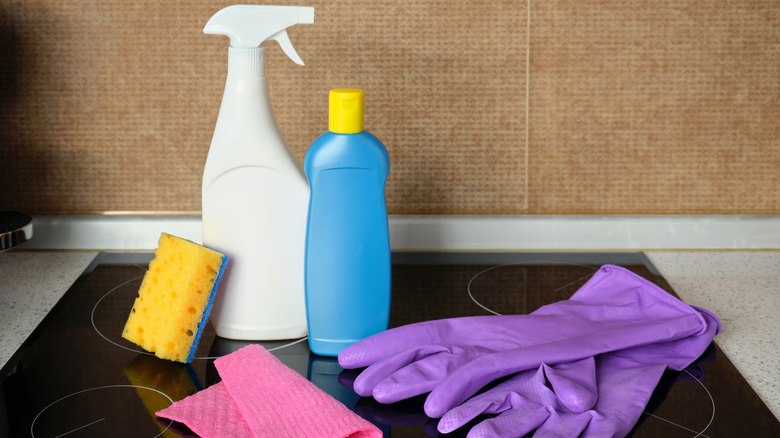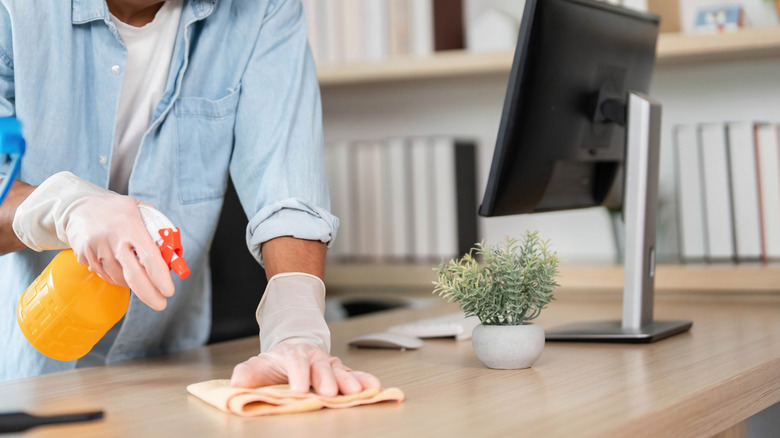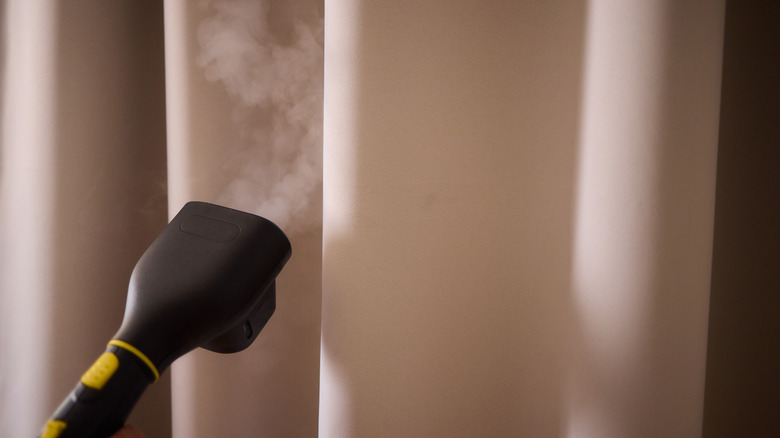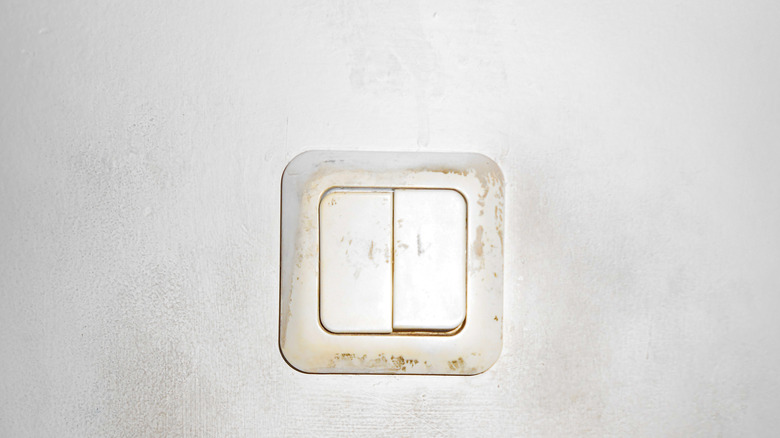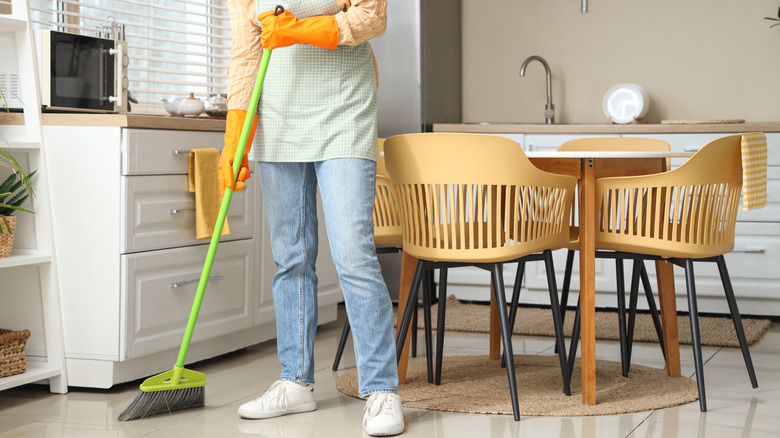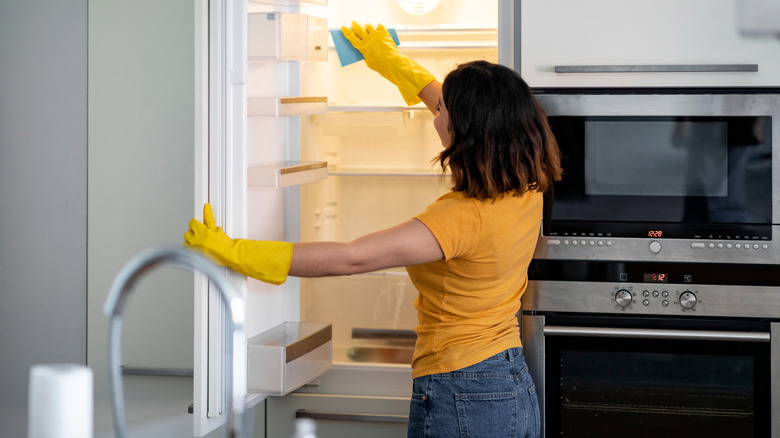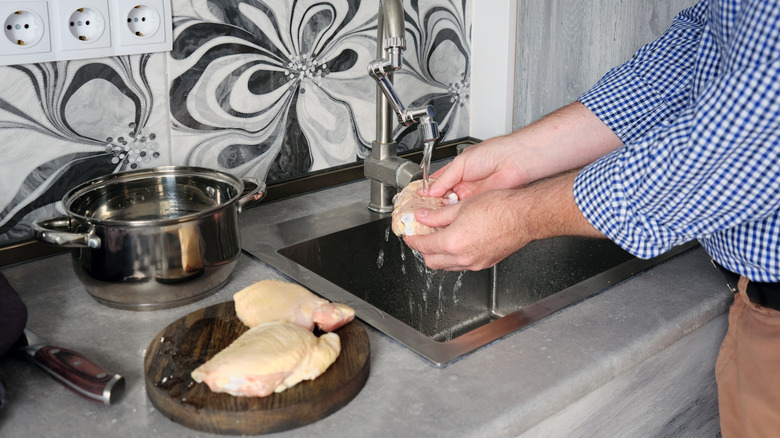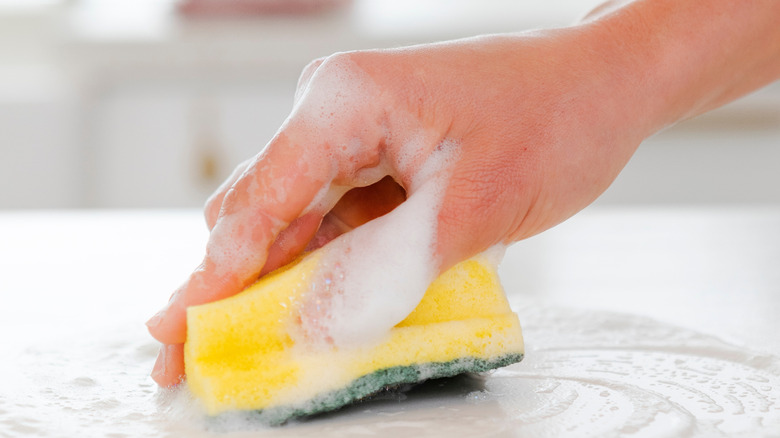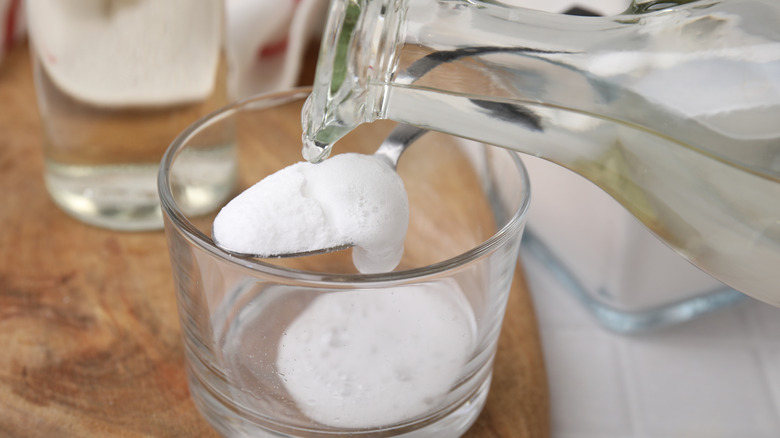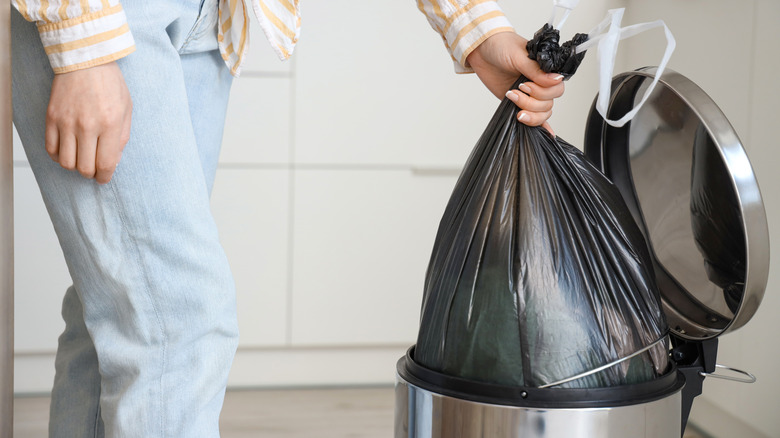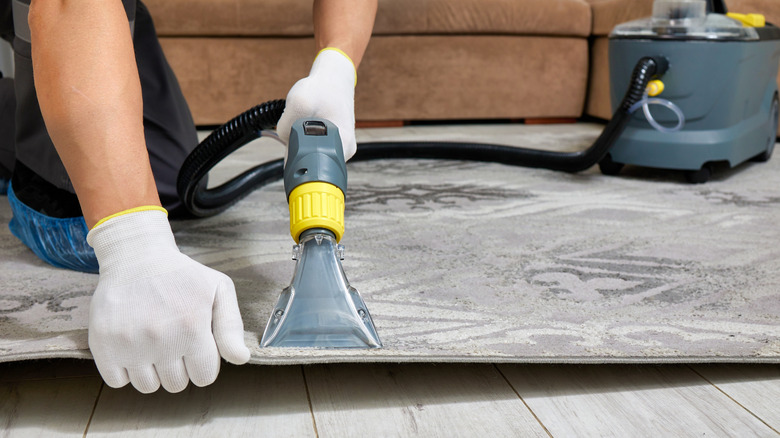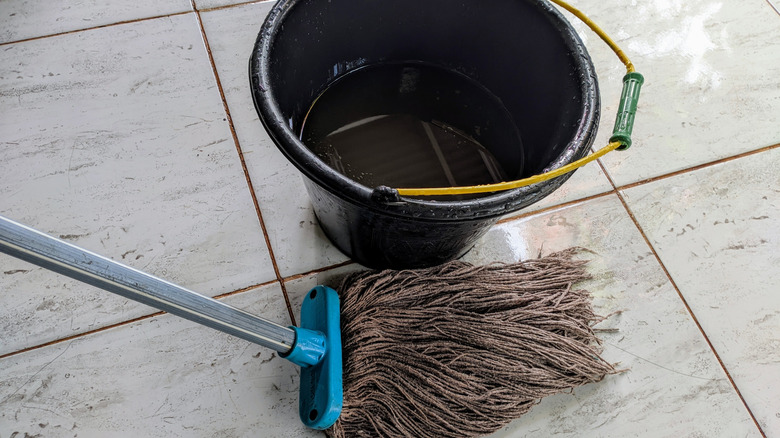You're Inviting Bacteria To Stay In Your Home With These 16 Cleaning Mistakes
We may receive a commission on purchases made from links.
Bacteria can cause all sorts of illnesses. So, naturally, you wouldn't want them in your immediate environment. But while maintaining a neat and tidy house will slow down bacteria growth, you might be making certain cleaning mistakes that can encourage these nasty pathogens to overstay their welcome.
For instance, one common mistake is not regularly removing knick-knacks from your counters and shelves to wipe under them and keep your surfaces clean. Failure to do this, or just trying to clean around items instead, allows the established bacteria to linger and spread to other areas of your home through cross-contamination. Forgetting to clean objects before putting them back on a disinfected surface is another error. So, if you're curious about the missteps that could be inviting bacteria to stay in your home, we've put together a list of 16 cleaning mistakes you might be making and ways you can take corrective action.
Not changing hand towels frequently enough
Having a hand towel by the sink is a smart move. Everyone can easily wipe their wet hands without tracking water through the bathroom. However, if you're forgetting to swap out the hand towel for a freshly laundered one, that means you're leaving a bacteria hotspot for everyone to touch. Besides people transferring germs from their hands (and the pathogens multiplying in the moist folds), the towel will become a breeding ground for bacteria if it's close to the toilet.
Launder your hand towels at least two to three times weekly. Dial up the frequency to daily if it sees a lot of use. Wash them separately from your other garments to stop cross-contamination. If possible, add a little laundry sanitizer, like Lysol Free & Clear detergent additive, to completely disinfect them.
Relying on dirty cleaning supplies to clean your home
You may be diligent about cleaning certain things in your home every day, but it'll just invite bacteria to stay longer if you use a dirty rag or sponge to wipe your counters, sinks, or toilet. A grimy cleaning tool harbors germs, and you'll be spreading them from one surface to the next. So, always check whether your mops, microfiber cloths, and brushes are clean before using them to scrub and wipe surfaces.
Launder your cleaning cloths after every use and add in 1 cup of baking soda if they're especially filthy or sport mysterious stains. Give your mop head similar treatment. Shake out your duster and broom after use. Deep clean the duster with warm water and dish soap every few months. Similarly, clean out the bristles of your scrub brushes with warm water and put them in the top rack of your dishwasher monthly (don't add dishes with the nasty tools). The hot water and detergent will take care of the dirt and bacteria. Don't forget to check the brush's care instructions first to avoid damaging it unknowingly. As for your toilet scrubbers, submerge them in a 1:10 ratio of bleach to hot water solution. You also want to clean the removable parts of your vacuum and its exterior with dish soap and warm water.
Wiping off disinfectants before the contact time is up
If you wipe away disinfectant instantly after application, you'll make it difficult for the solution to eliminate all the nasty germs on your kitchen counter, bathroom sink, or toilet seat. This is because these solutions often require a couple of seconds or a few minutes to work as intended. And, if you wipe it off early, not only will the bacteria remain undefeated, but it could also conquer other areas, especially if you use the same cloth to wipe surfaces.
To ensure you don't disrupt the disinfectant while it's killing off harmful bacteria, let it stay untouched for the time span, or "contact time," listed on its label. If the label recommends leaving a surface "visibly wet" for the duration, use the product liberally so it doesn't dry out before the time is up. If possible, invest in disinfectants with a contact time of less than two minutes. Otherwise, you'll have to use more product to keep the surface covered. Only skip this step if the cleaner you're using promises to instantly kill germs or is labeled "no-wait."
Using an all-purpose cleaner in place of a disinfectant
There's no denying that all-purpose cleaners will make getting rid of stains, spots, and baked-on gunk easier. However, they won't help eliminate all the lingering bacteria and viruses from surfaces. And this simple mistake will encourage these microorganisms to breed rapidly and cover more square footage. So, you need a disinfectant to prevent the germs on your surfaces from spreading further. That being said, not every all-purpose cleaner is hopeless against pathogens. For instance, Lysol's Disinfectant Cleaner Spray is one of the best all-purpose cleaners worth buying for your kitchen and will disinfect all non-porous surfaces.
Although you don't want to harbor bacteria in your home, you don't have to use disinfectants on all surfaces and objects. Instead, employ them to disinfect high-risk areas in your home. For example, you must disinfect your kitchen countertop, especially after you handle raw meat. You'll also want to sanitize areas after you or someone in your home has been sick.
Forgetting to clean surfaces before disinfecting them
While you need a disinfectant to kill bacteria on hard surfaces, you must clean them first so that the product can work as intended. This is necessary because the accumulated dirt, dust, and debris will make it harder for the chemicals to penetrate and make it easier for bacteria to hide, defeating the purpose of using the disinfectant. Follow this process even if a product is both a cleaner and disinfectant.
The good news is you don't need a dedicated cleaner for non-porous surfaces and objects, like counters and toys. A soap and water combo works well in most cases and will help get rid of the built-up grease and grime. Regarding soft furnishings, vacuum your curtains before throwing them in the washer or subjecting them to a steam cleaner.
Failing to sanitize high-touch areas
A cleaning mistake you might be making is overlooking high-touch surfaces, like light switches, door knobs, remotes, toilet flushes, microwave buttons, doorbells, and fridge handles. Basically, items that you and other people (like Amazon delivery drivers) touch regularly. Since bacteria from your hand can easily transfer onto these areas, you should regularly sanitize them, too.
Luckily, you don't have to disinfect high-touch surfaces often; a weekly schedule will suffice. That being said, you should clean them immediately after you host guests (you don't know how clean their hands are, so why risk it?) or up the frequency if someone in your home is sick. Clean these areas with a slightly damp microfiber cloth to cut through the grease and sweat sticking to the surface before wiping them down with a sanitizing product like Lysol Disinfectant Wipes. Turn off the mains and be cautious — trade the damp cloth for a dry one or wring out a wet wipe — when rubbing down your light switches or electronic gadgets (think battery-operated remotes) to keep excess moisture from seeping in.
Trying to remove dust build-up with a dry cloth or duster
A dry microfiber cloth or a feather duster is fine if you're using it as part of your daily dusting routine. However, one common mistake everyone makes when using microfiber cloths is using them dry to remove layers of accumulated dust. Avoid this, or you'll only succeed in shifting dust from one surface to another instead of eliminating it. And this honest mistake will encourage the hidden bacterial colonies to stay long-term.
So, whenever you want to wipe away built-up dust and dirt from hard surfaces, like ignored baseboards, crusty vents, nasty-looking ceiling fans, and grimy doors, dampen a clean microfiber cloth. For best results, submerge cloths in warm water for a couple of minutes first before wringing them out thoroughly. Ensure cloths are only damp and not soaking wet — otherwise, you'll have to wipe surfaces again with a dry one.
Sweeping your floors before tackling the ceilings and walls
Sweeping your floors prior to dusting cobwebs off your ceiling might sound like a good idea. However, you don't want to tackle the floors before dusting higher places, or the accumulated dirt and dust will rain down on your freshly swept floors, undoing your hard work. The bacteria communities nestled within the dust bunnies will also find fresh surfaces to attach themselves to, compromising your home's hygiene. In a similar fashion, don't mop the floors if you're yet to clean the walls or shelves in a room.
To clean your ceilings, arm yourself with a long-handled duster or clip on the soft brush attachment on your vacuum and pick the low power mode setting. In case you notice a few stains, get a spray bottle and combine distilled white vinegar and water in a 1:1 ratio. Dampen a microfiber cloth and scrub the stains gently. Dust your light fixtures and vent openings, too. Once you're done, vacuum the walls before sweeping and mopping your dirty floors.
Not assigning each room a different microfiber cloth
Although it simplifies things, cleaning the different rooms in your home with the same microfiber cloth will carry bacteria from one spot to another. For instance, if you use a cloth to wipe your kitchen counters, then use it to clean your bathroom surfaces, or vice versa, you risk spreading the germs. The risk is greater if foods like meat juices or raw eggs have come into contact with the cloth. And, if your starting point is your bathroom, you definitely don't want to use the same cloth to wipe your living spaces and bedrooms.
To minimize the risk of cross-contamination, assign each room a different microfiber cloth. Since it can be difficult to remember which cloth you assigned to which room, use a color-code system and set aside different colored cloths (handy products like Homexcel's 12 Pack of Cleaning Rags make this easier) for each room in your home. Alternatively, maintain the same-colored cloths for your entire home but always reach for a fresh rag whenever you switch rooms.
Neglecting to deep clean your fridge every three months
While wiping down your refrigerator exterior every few days will keep it looking new, ignoring the inside will encourage spoilage bacteria to run rampant and can cause your fridge to give off rancid odors. To avoid storing your meat, fruits, and veggies in the same space inhabited by bacteria, give the appliance a deep clean each quarter. That being said, you should wipe the insides sooner if you accidentally spill milk or other foodstuffs on the shelves. This will prevent microorganisms from multiplying. Additionally, you should sanitize the shelves after you remove spoiled food to eradicate lingering bacteria.
The first step is to unplug the appliance and remove everything stored inside. Then, take out all the detachable shelves and compartments, and let them reach room temperature. In the meantime, try an easy vinegar hack for a squeaky-clean fridge interior. All you have to do is mix distilled white vinegar and warm water in a 1:1 ratio, and spray it on the gasket and fixed shelves. This mild cleaning solution will degrease and disinfect the area without being too harsh on the parts. Plus, it's food-safe.
If the interiors are dirty, wipe them down with soapy water before applying the vinegar and water solution (remember, cleaning before disinfecting). Finally, rub them down with a damp microfiber cloth to wipe away residual cleaning solution. Scrub the shelves using a hot water and dish soap solution and let them air dry.
Not sanitizing your kitchen and bathroom sinks
You might think that soap residue from your dishes and hands keeps your kitchen and bathroom sinks clean. Unfortunately, these moist and damp areas are germ hotspots. In fact, kitchen sinks are generally the second-most germiest place in a house. And cross-contamination from handling and washing raw meat only worsens matters. Stuck food particles in the drain also support bacterial growth. Your bathroom sinks don't fare better, either, as dirty hands introduce their fair share of bacteria. Moreover, stuck cleaning products and hair clumps in the drain further shelter bacteria and give them more items to cling to for dear life.
To make sure bacteria don't take over the sinks in your house, scrub these areas with warm, soapy water. Next, spray a disinfectant and let it air dry. In case you don't have a disinfectant handy, combine 1 tablespoon of bleach with around a gallon of water and use this instead. Repeat this process every time you wash meat in the sink or nightly to prevent bacterial growth. You also want to clean an overlooked kitchen appliance — the garbage disposal — each week. Sanitize the drains with hot water, and loosen stuck debris with baking soda and distilled white vinegar.
Scrubbing your kitchen counters with the same sponge you use for your dishes
Kitchen sponges are the dirtiest item in a home. In fact, a NSF Household Germ Study found that 75% of household dish sponges host Coliform bacteria, which includes disease-causing pathogens like Salmonella and E. coli. Even more concerning, one HGIC study found over 7.9 million bacteria on each sponge across 14 college student apartments. Since sponges are absorbent and take a lot of time to dry, bacteria thrive in their tiny compartments. Add in residual food particles, and the pathogens have no reason to ever abandon the sponge. And when you use the same sponges to wipe down your counters, you allow the bacteria free rein over these surfaces.
So, always clean your dish sponge weekly (minimum) and never use it to wipe other areas. You can either place it on the top rack of your empty dishwasher and run a high heat cycle or microwave a wet sponge for about 60 seconds. Otherwise, replace them after a week or two and switch out torn sponges at once.
Using a combination of baking soda and vinegar to discourage germs
You may believe that combining baking soda and distilled white vinegar will help sanitize dirty objects around your house. But don't let the dramatic fizzing fool you. It's a simple chemical reaction that makes kids' volcanoes "spew lava" in a science experiment. Essentially, the base (baking soda) reacts with the acid (vinegar) to form carbon dioxide. And the salty water left behind is neither an effective cleaner nor a disinfectant. This combo is only impactful when you're hoping to unclog your drains or clean out pipes.
It's actually better to use these two products separately. Baking soda will help clean multiple items around your home, like coffee pots and bathroom floors, while vinegar can take on tough jobs, such as cleaning a Cuisinart coffee maker. Vinegar can take on certain household bacteria, too, but you'll need a dedicated disinfectant to get rid of them altogether.
Taking out the trash but not cleaning the can
Taking out the trash is a simple chore you can do on a quick commercial break. Although an efficient use of time, you'll invite bacterial spread if you don't clean the bin. This is because even with the liner protecting the can from the worst, sneaky crumbs and accidental leaks make their way through. The dark and moist environment not only attracts pathogens but also pests like cockroaches and flies. Stomach-turning stench is another problem you'll have to face.
So, clean out the garbage can twice a week if you put most of your household trash in it. Otherwise, a weekly clean will work, too. But to truly discourage bacteria from gaining a stronghold, spray it with a disinfectant as well and let the bin dry before placing a fresh bag inside.
Failing to deep clean your carpets and rugs seasonally
Vacuuming your rugs and carpets weekly will get rid of surface-level dirt, food crumbs, and pet dander. Yet, it's not enough to pull out the bacteria surviving and thriving in the fibers. This is why you should deep clean them twice a year to shoo the pathogens away.
Start by vacuuming the rugs and carpets. The hoover will suck in the surface-level dirt, dust, and debris so your disinfecting appliances can focus on getting the bacteria out. Once you're done with the front side, flip rugs over to give them a deeper clean, then wash them on the "sanitize" cycle if the material is machine-friendly (if not, wash it by hand). You can also add in a little laundry sanitizer per the manufacturer's instructions. And, if the care instructions discourage both kinds of washing or you're cleaning wall-to-wall carpeting, move on to the next step: using a steam cleaner, such as Bissell's Little Green HydroSteam cleaner. The high temperatures will eliminate hidden bacteria and minimize the risk of them staying over. If you don't want to invest in a steam cleaner, have a professional clean your carpets.
Using dirty mop water to wipe your floor
Using one bucket of water and not changing it often when mopping will help spread bacteria, as you'll be just swashing filth around on your floors instead of cleaning them. The results will be similar if you don't use a disinfectant, since plain water or even a soap and water combo won't eliminate all pathogens.
In case you don't want to give yourself a backache spreading bacteria around your house, follow a dual mop bucket system. It'll keep the clean water separated from the dirty water you swish your mop in after wiping your living room floor. Add a little disinfectant, like rubbing alcohol, to the clean water to eliminate bacteria and prevent cross-contamination. Consider your flooring type before picking a product to avoid regrets later on.
